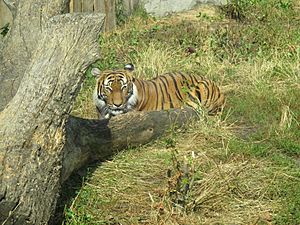Malayan tiger facts for kids
Quick facts for kids Malayan tiger |
|
|---|---|
 |
|
| A Malayan tiger in water | |
| Conservation status | |
| Scientific classification | |
| Kingdom: | |
| Phylum: | |
| Class: | |
| Order: | |
| Family: | |
| Genus: | |
| Species: | |
| Subspecies: |
P. t. jacksoni
|
| Trinomial name | |
| Panthera tigris jacksoni |
|
 |
|
| Range map | |
The Malayan tiger (Panthera tigris jacksoni) is a special type of tiger. Scientists officially recognized it as a new subspecies in 2004. Before this, people thought these tigers were part of the Indochinese tiger group. Now, we know they are unique!
Malayan tigers live in the southern parts of Malaysia. Sadly, they are an endangered species, meaning there are very few left in the wild.
Contents
What Makes Malayan Tigers Special?
It can be hard to tell the difference between a Malayan tiger and an Indochinese tiger. Even when scientists compare their skulls or fur, they look very similar.
Malayan tigers seem to be a bit smaller than Indian tigers. Male Malayan tigers are usually about 2.6 meters (8 feet 6 inches) long. Females are a bit shorter, around 2.4 meters (7 feet 10 inches) long.
In the State of Terengganu, female tigers were measured. Their body length was between 178 to 262 centimeters (70 to 103 inches). On average, they were about 203 centimeters (80.1 inches) long. They stood about 58 to 104 centimeters (23 to 41 inches) tall. Their weight ranged from 24 to 88 kilograms (52 to 195 pounds).
Male tigers in the same area were also measured. Their total length was between 190 to 284 centimeters (75 to 112 inches). The average length was 239 centimeters (94.2 inches). They were about 61 to 114 centimeters (24 to 45 inches) tall. Their body weight was from 47 to 129 kilograms (104 to 284.7 pounds).
Where Malayan Tigers Live
The exact border between where Malayan tigers and Indochinese tigers live is not clear. This is because tiger groups in northern Malaysia are connected to those in southern Thailand. Tigers used to live in Singapore, but they disappeared from there in the 1950s. The last tiger in Singapore was seen in 1932.
From 1991 to 2003, signs of tigers were found in different areas. These included farm fields and areas near rivers in states like Kelantan, Terengganu, Pahang, and Johor. Most major rivers flowing into the South China Sea showed tiger activity. However, rivers flowing into the Strait of Malacca in the west did not.
Tigers were not found in Perlis, Penang, or Malacca. They were also not seen in the big cities of Kuala Lumpur and Putrajaya. The total area where tigers could potentially live was about 66,211 square kilometers (25,564 square miles). This included confirmed tiger homes and places where they were expected or possibly lived. All protected areas larger than 402 square kilometers (155 square miles) had tigers.
In 2014, a survey using camera traps estimated the number of Malayan tigers. They found only 250 to 340 healthy tigers left. This big drop in numbers means the Malayan tiger might soon be listed as "Critically Endangered." This is the highest risk category on the IUCN list.
What Malayan Tigers Eat
Malayan tigers hunt many different animals. Their main prey includes sambar deer, barking deer, wild boar, and Bornean bearded pigs. They also eat serow, sun bears, young elephants, and rhino calves. We don't know if they regularly hunt large animals like adult gaur or tapir.
Sometimes, tigers might hunt livestock (farm animals). However, tigers are important for keeping nature balanced. For example, they help control the number of wild boar. Too many wild boar can cause problems for farms and plantations. Studies show that in places without big predators like tigers, wild pigs are much more common.
Tigers live in rainforests, but there aren't many of them. This is because there isn't a lot of prey for them to eat. To keep a healthy group of tigers, protected areas need to be very large, over 1,000 square kilometers (386 square miles).
Threats to Malayan Tigers
Malayan tigers face several big dangers. One major threat is Habitat fragmentation. This happens when their natural homes are broken up into smaller pieces. This can be due to new buildings, roads, or farms. When their habitat is split, tigers find it harder to find food and mates.
Another serious threat is poaching. Poaching means illegally hunting animals. In Malaysia, there's a market for tiger meat and products made from tiger bones. These are sometimes used in traditional medicines. This illegal hunting greatly reduces the number of tigers.
Protecting Malayan Tigers
Tigers are protected by an international agreement called CITES. This agreement bans the buying and selling of tigers and their parts across countries. Many countries where tigers live, and countries where tiger products are bought, have also banned local trade.
The Malaysian Conservation Alliance for Tigers (MYCAT) is a group working to save these tigers. It's made up of several environmental organizations like the Malaysian Nature Society and WWF-Malaysia. The Malaysian government's Department of Wildlife and National Parks is also part of MYCAT.
In 2007, MYCAT started a special phone line. People can use it to report crimes against tigers, like poaching. To stop poachers, they also organize "Cat Walks." These are patrols by citizens in areas where tigers are in danger. MYCAT's main goal is to help the tiger population grow.
Malayan Tigers in Zoos
Zoos also play a role in protecting Malayan tigers. The Cincinnati Zoo was the first zoo in North America to start a special breeding program for them. This began in the early 1990s.
There are also some Malayan tigers in the Zoo Taiping and Night Safari in Malaysia. As of 2011, there were 54 Malayan tigers in zoos across North America. These tigers came from only 11 original tigers. To keep the tigers healthy and diverse, zoos hope to bring in more tigers from the wild. This will help make sure the tigers in zoos stay strong for many years.
Images for kids
See also
 In Spanish: Tigre malayo para niños
In Spanish: Tigre malayo para niños






